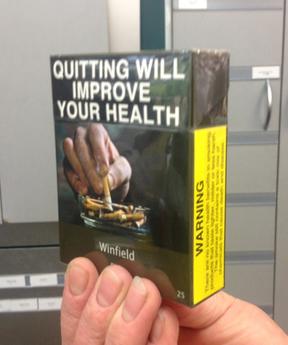Plain tobacco packaging
Plain tobacco packaging, also known as generic, standardised or homogeneous packaging, is a public health policy that requires the removal of all branding (colours, imagery, corporate logos and trademarks), permitting manufacturers to print only the brand name in a mandated size, font and place on the pack, in addition to the health warnings and other legally mandated information such as toxic constituents and tax-paid stamps. The aim of plain packaging is to reduce the attractiveness of tobacco products, to increase the noticeability of health warnings, and to reduce the use of the packaging as a form of advertising and promotion.
Background[edit | edit source]
Tobacco use is one of the leading causes of preventable deaths globally. The World Health Organization (WHO) estimates that tobacco causes more than 8 million deaths per year around the world. Recognizing the role of packaging in promoting tobacco use, the WHO Framework Convention on Tobacco Control (FCTC) recommends plain packaging as a means to reduce the appeal of tobacco products, particularly among young people and non-smokers.
Implementation[edit | edit source]
The first country to implement plain tobacco packaging was Australia in December 2012, followed by several other countries including France, the United Kingdom, New Zealand, and Norway. The implementation of plain packaging involves specific regulations regarding the appearance of tobacco packs. These regulations typically include:
- Prohibition of logos, colours, brand images or promotional information on packaging except for the brand and product names displayed in a standard colour and font style.
- Standardisation of the packaging colour (usually a drab dark brown or olive green) to make tobacco products less appealing.
- Increase in the size of health warnings on the front and back of the tobacco product packaging.
Effectiveness[edit | edit source]
Research indicates that plain packaging can reduce the attractiveness of tobacco products among users and non-users, decrease tobacco consumption, and increase the effectiveness of health warnings on the packaging. Studies from countries that have implemented plain packaging show a decline in smoking prevalence. However, the tobacco industry and some trade organizations have argued that plain packaging infringes on intellectual property rights and may lead to an increase in the illicit trade of tobacco products.
Controversy and Legal Challenges[edit | edit source]
The introduction of plain packaging has faced significant opposition from the tobacco industry, which has launched legal challenges against governments implementing these measures. The main arguments include potential violations of intellectual property rights and international trade laws. However, the World Trade Organization (WTO) upheld Australia's plain packaging laws in 2018, setting a precedent that supports the legality of plain packaging under international trade agreements.
Conclusion[edit | edit source]
Plain tobacco packaging is a public health measure aimed at reducing the appeal of tobacco products, increasing the visibility of health warnings, and ultimately reducing tobacco consumption and its associated health risks. Despite legal challenges and opposition from the tobacco industry, evidence from countries that have implemented plain packaging demonstrates its effectiveness as part of comprehensive tobacco control efforts.
Search WikiMD
Ad.Tired of being Overweight? Try W8MD's physician weight loss program.
Semaglutide (Ozempic / Wegovy and Tirzepatide (Mounjaro / Zepbound) available.
Advertise on WikiMD
|
WikiMD's Wellness Encyclopedia |
| Let Food Be Thy Medicine Medicine Thy Food - Hippocrates |
Translate this page: - East Asian
中文,
日本,
한국어,
South Asian
हिन्दी,
தமிழ்,
తెలుగు,
Urdu,
ಕನ್ನಡ,
Southeast Asian
Indonesian,
Vietnamese,
Thai,
မြန်မာဘာသာ,
বাংলা
European
español,
Deutsch,
français,
Greek,
português do Brasil,
polski,
română,
русский,
Nederlands,
norsk,
svenska,
suomi,
Italian
Middle Eastern & African
عربى,
Turkish,
Persian,
Hebrew,
Afrikaans,
isiZulu,
Kiswahili,
Other
Bulgarian,
Hungarian,
Czech,
Swedish,
മലയാളം,
मराठी,
ਪੰਜਾਬੀ,
ગુજરાતી,
Portuguese,
Ukrainian
Medical Disclaimer: WikiMD is not a substitute for professional medical advice. The information on WikiMD is provided as an information resource only, may be incorrect, outdated or misleading, and is not to be used or relied on for any diagnostic or treatment purposes. Please consult your health care provider before making any healthcare decisions or for guidance about a specific medical condition. WikiMD expressly disclaims responsibility, and shall have no liability, for any damages, loss, injury, or liability whatsoever suffered as a result of your reliance on the information contained in this site. By visiting this site you agree to the foregoing terms and conditions, which may from time to time be changed or supplemented by WikiMD. If you do not agree to the foregoing terms and conditions, you should not enter or use this site. See full disclaimer.
Credits:Most images are courtesy of Wikimedia commons, and templates, categories Wikipedia, licensed under CC BY SA or similar.
Contributors: Prab R. Tumpati, MD

